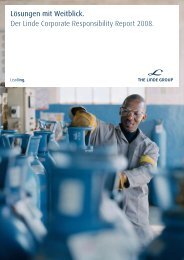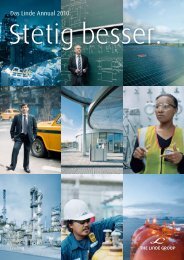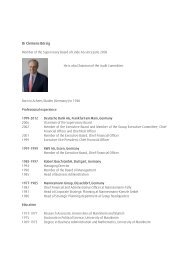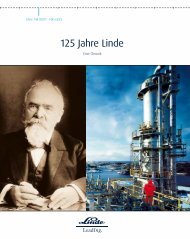The complete history of the development of The - The Linde Group
The complete history of the development of The - The Linde Group
The complete history of the development of The - The Linde Group
Create successful ePaper yourself
Turn your PDF publications into a flip-book with our unique Google optimized e-Paper software.
1973 1974<br />
OPEC restricts supply and triggers<br />
international oil crisis.<br />
N o 2251 Process and device<br />
for <strong>the</strong> cooling <strong>of</strong> objects or materials.<br />
Discussion <strong>of</strong> future direction<br />
Starting in <strong>the</strong> mid-1960s <strong>the</strong> Executive Board <strong>of</strong> <strong>the</strong> <strong>Linde</strong> Company<br />
engaged in a highly controversial strategy debate whose<br />
outcome was unknown. Indications <strong>of</strong> economic problems,<br />
above all in <strong>the</strong> refrigeration division and at Güldner, and <strong>the</strong><br />
general sense <strong>of</strong> an increasing “technological gap” compared<br />
with <strong>the</strong> United States led to uncertainty and strategic considerations<br />
in <strong>the</strong> company which would soon change both <strong>the</strong> leadership<br />
structure and <strong>the</strong> corporate culture.<br />
First <strong>the</strong> Executive Board decided on a few somewhat<br />
cosmetic changes: <strong>The</strong> now old-fashioned sounding name<br />
“Gesellschaft für <strong>Linde</strong>’s Eismaschinen” was changed to <strong>the</strong> short,<br />
concise <strong>Linde</strong> AG in 1965. <strong>The</strong> plant groups were named after<br />
<strong>the</strong>ir geographical location – Munich, Sürth, Aschaffenburg and –<br />
breaking from <strong>the</strong> pattern – refrigerated buildings; <strong>the</strong> production<br />
lines were now called divisions: low temperature engineering<br />
and process technology; technical gases; welding technology;<br />
refrigerated buildings; compressors, expansion turbines,<br />
compressed air tools; refrigeration and air conditioning; refrigeration<br />
and freezer units; hydraulics; diesel engines; tractors and<br />
industrial trucks.<br />
With <strong>the</strong> weak economy and <strong>the</strong> early globalization starting<br />
in <strong>the</strong> second half <strong>of</strong> <strong>the</strong> 1960s, <strong>the</strong> strategic discussions in<br />
<strong>the</strong> <strong>Linde</strong> AG Executive Board intensified. Dr. Hans Meinhardt<br />
primarily set <strong>the</strong> tone. He joined <strong>the</strong> company in 1955, was<br />
promoted to <strong>the</strong> top management <strong>of</strong> Güldner in Aschaffenburg<br />
in 1963 and beginning in May 1965 also acted as assistant to<br />
<strong>the</strong> deputy chairman <strong>of</strong> <strong>the</strong> Executive Board and head <strong>of</strong> central<br />
administration, Dr. Johannes Simon.<br />
From this position, Meinhardt introduced <strong>the</strong> structural<br />
changes which he purposefully <strong>complete</strong>d as speaker <strong>of</strong> <strong>the</strong><br />
Executive Board beginning in 1976.<br />
<strong>The</strong> Watergate scandal leads to <strong>the</strong> resignation<br />
<strong>of</strong> US President Richard Nixon.<br />
Höllriegelskreuth in <strong>the</strong> ethylene plant boom: Armin Dorner (center) explains<br />
a model <strong>of</strong> <strong>the</strong> Scholven, Germany ethylene plant to a delegation.<br />
<strong>The</strong> finished Scholven ethylene plant in <strong>the</strong> late 1960s.




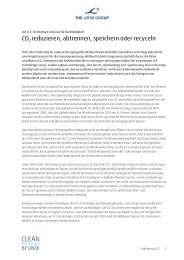

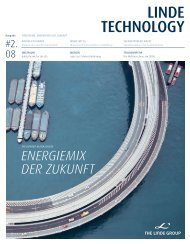

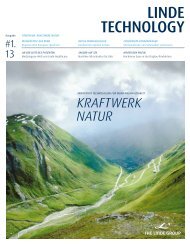

![[41] Anteilsbesitzliste des Linde Konzerns und ... - The Linde Group](https://img.yumpu.com/8356102/1/184x260/41-anteilsbesitzliste-des-linde-konzerns-und-the-linde-group.jpg?quality=85)
![[41] Anteilsbesitzliste des Linde Konzerns und ... - The Linde Group](https://img.yumpu.com/8356076/1/184x260/41-anteilsbesitzliste-des-linde-konzerns-und-the-linde-group.jpg?quality=85)
